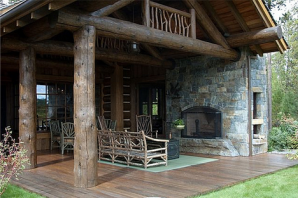6 Tips To Make Your Log Home Last and Last

Did you know that if a log home is well taken care of, it can last for centuries? Yes, it’s true! And let’s face it, you’ve invested a lot of hard-earned money into your log home and keeping it in pristine condition should be at the top of your priority list. Log home maintenance doesn’t have to be stressful as long as you follow regularly-scheduled preventative measures to ensure your prized possession is as pampered as your car—oil changes, tune-ups, replacing old parts and keeping your vehicle free from corrosives is all part of the preservation process; and you log home is no different.
Though not all measures for preserving your log home will be covered here, the tips to make your log home last presented will cover those interventions that should be at the top of your maintenance list.
Tips To Make Your Log Home Last
1: Treating Your Logs:
If your log home is new or has some logs that have been replaced and are still free of finishing products, then apply a borate solution to any unfinished logs. This is an excellent treatment for the prevention of a variety of wood-digesting insects, decay and log rot. Borate will be applied only once, while the logs are bare; and it will become locked in for life once the stain is applied. This, of course, means the staining process must be kept up-to-date, otherwise, the borate will lose its effectiveness. If the log company has already pressure treated any new, bare logs with borate, then you will not need to repeat this process.
If you have logs that have been stained, borate treatments can be done via impel or cobra rods. What you’ll do is drill a hole in the wood and impel the rod into the wood and the borate will diffuse into the wood fibers.
2: Cleaning/Finishing Your Logs:
Did you know that dirt on wood is like salt on a car? Salt will break down the finish of a car and dirt will break down the log’s finish which will lead to superficial and internal damage. Cleaning your log home at least once a year to free it of mold, mildew, dirt, pollen and a host of other contaminants is vital. Using a commercially-prepared log-wash is recommended since even mild cleansing agents you have around the house can contain detergents that may leave a residual film which will compromise necessary adhesion of caulking and chinking. Rinsing thoroughly after a wash is so important and a second rinse is recommended to make sure all the cleansing ingredients have been eliminated.
A finish coat should be applied regularly and that can range from between once a year to once every 4 or 5 years depending on how abusive the weather and sun exposure has been as well as the quality of the finishing product. A high-quality product will optimally safeguard against blistering and cracking for years.
3: Giving Your Stains A Long Life:
If you want your stains to last, you simply MUST use a high-quality product!
*** Clean logs with a chemical wash and thoroughly rinse, once a year! This will prevent the finish from breaking down.
*** When staining, pay particular attention to the ends of the logs since it is here where the grain is exposed and very vulnerable to moisture and insects.
*** Don’t forget the clear, topcoat! A clear topcoat is a stain’s right-hand man and acts like a 24/7 bodyguard. It will provide additional and needed protection from wind, moisture, UV radiation and fading. Unlike paint, stain products possess fewer protective agents and must, therefore, receive an added defense-system that a topcoat provides. Don’t skimp on the touch-up applications of topcoat between full refinishing projects. Touch-ups will provide all the water repellency your logs will need and this will extend the life of the stain.
4: Getting Into The Groove!
Yes, you need to get into the groove---tongue and groove profiles, that is! Construction methods can make a difference concerning the overall longevity and performance of your log home; and some log walls fit together tighter than others; and the ‘tongue-and-groove’ profile is known for its tight-fitting design. If tongue-and-groove profiles are carved at the top and bottom of each log, your log walls will form a superior tight fit and seal.
5: Get Into Those Gutters!
Your gutter system plays a vital role with making sure excess water is directed, as much as possible, away from your logs. Every spring and fall, grab your ladder and make a thorough inspection of the gutter trays and remove any and all debris. If debris is allowed to remain, water will flow erratically when it rains and cause splattering and moisture overload to your logs, resulting in eventual rotting.
And while you’re checking those gutters, examine your roof twice a year for any moss or lichen growth. These culprits will damage your wood, as well, so spraying them off with a pressure hose—at a low setting—will be doing your roof a huge favor.
6: Check That Chinking!
Improperly installed or failing caulk and chink is one of the primary causes for log rot. Any cracks or checks, no matter how small, must be repaired to prevent wind, water and bugs from entering your home. Inspect the condition of your caulk every spring and fall and fill even hair-line cracks around windows, doors, between log courses and in all corners.
You want your log home to last for generations; and when you incorporate a regular maintenance schedule, your log home will offer you the kind of beauty and durability you expect. It’s your home-sweet-home; and when you take care of it, it will take care of you!
